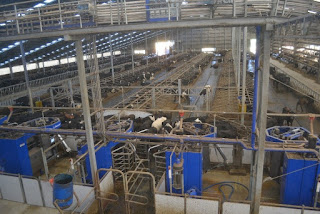Day 5
Today, we traveled around 30 minutes to a Hereford stud farm near Reporoa called Kairuru polled Herefords. This is a family owned farm by Kevin and Jane McDonald alongside with their son Jeff. This farm is approximately 450 acres that hold around 100 cows, 100 steers, and approximately 400 feeder lambs. This family had the top selling bull at the Fiordland beef expo in New Zealand.
 |
|
Kairuru Polled Hereford Stud bulls.
|
Kevin
and Jane breed their bulls for calving ease along with good size carcasses and
sound structured feet because of the terrain they are on. They focus on calving
ease because they are crossing beef bulls with dairy cattle and dairy farmers
are adamant for having calving-ease bulls. The New Zealand Hereford association requires
the McDonald family to breed for the eye pigment which is a brown eyeliner
appearance on the animal. This is required because there is a hole in the ozone
layer over New Zealand which causes the UV rays to damage and cause eye cancer
in the Herefords. They also breed for the iconic four white feet and tail in
order to be a registered Hereford.
 |
| Curiosity kills the calf; Hereford steers at the McDonald farm. |
 |
|
Jeff McDonald talking to us about the calf sale barn.
|
Along
with the herd of cattle, they also partner in running a calf sale barn where,
at 4 days old, they separate out the Hereford and dairy cattle. If they don’t
go to this sale barn, they get put on the bobby calf truck where they are sent
to be used as veal. This sale barn runs from the months of June through
September, and approximately 1000 calves are run through every week. Last
season, they had approximately 7000 calves sold averaging $150 each. After each
sale, the barns are cleaned using a Bobcat and 150L of disinfectant gets
sprayed by an irrigation pipe throughout the sale barn.
 |
| Roaring Huka falls |
The next
stop after the Hereford farm was the Huka Falls in Taupo. Here we saw the
beautiful sites of the turbulent waters which flow from Lake Taupo, which is
the biggest lake in New Zealand. From here, we drove a couple of minutes into
town and ate lunch at Dixie Brown’s right on the lake, where many of us enjoyed
burgers or fresh fish. After lunch, many of us strolled around town to do some
shopping, as well as take in the beautiful view of the lake.
 |
| Group picture on the way to Taupo |
 |
|
The waves of the ocean on Hawke’s Bay.
|
From
here, we traveled approximately two hours to the city of Napier, which is one
of the two main cities of Hawke’s Bay. Much of Napier was destroyed in 1931,
when an earthquake took place in the town. While here, many of us jumped off
the bus and walked down to the ocean along the beach. While in Napier, a man by
the name of Derek Barnes met with us and showed us around the many vineyards
and orchards in the area, since this area is known as the “fruit basket” of the
country. Throughout this region, they are prone to frost during the season, so
they put up wind machines that draw warm air down in order to prevent frost on
the plants. He also explained to us that one millimeter of water is equal to
one degree of frost protection. We finally arrived at Heretaunga Plains, where we
were shown Mr. Barnes’ fruit production farm where he grows apples, kiwi,
peaches, plums, and feijoa. We all were extremely pleased when we were able to
taste test both the feijoa fruit, along with the kiwis. Throughout our time
here, Mr. Barnes gave us very important information about the bees and the fact
that they are absolutely necessary in order for pollination to occur, and without
pollination there would be no fruit. This last year, the Barnes family picked
approximately 60 tons of kiwi, which is abnormally low due to a devastating
hail storm earlier in the season. The normal crop of kiwi is approximately
85-90 tons per year.
 |
| Kiwi plants at the Hereaunga Plains. |
We are
now stopped in Hastings, and checked into our motel for the night. We had
another great day here in New Zealand, and are extremely excited for what
tomorrow brings.
Jayd & Ashley




Comments
Post a Comment